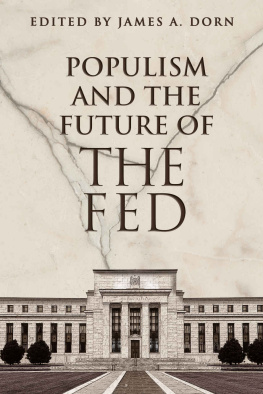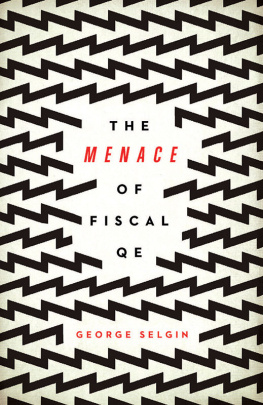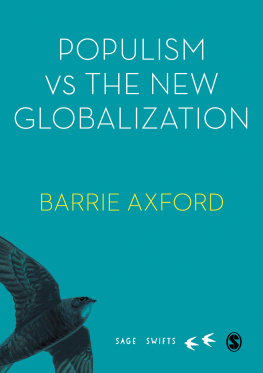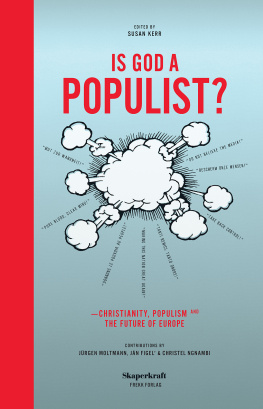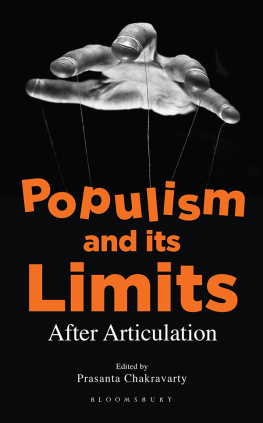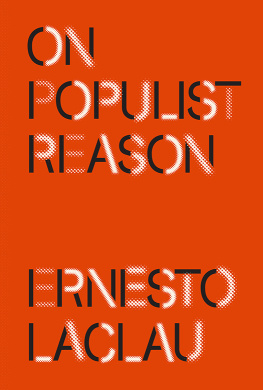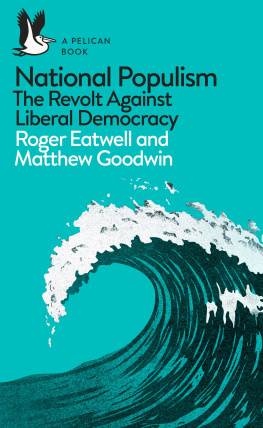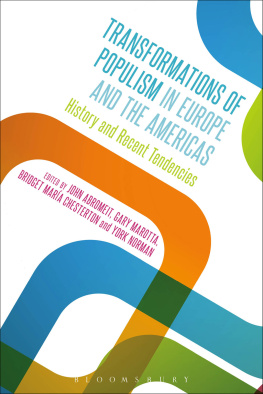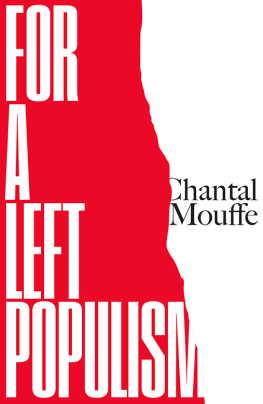Copyright 2022 by the Cato Institute
All rights reserved
ISBN: 978-1-952223-54-9
eBook ISBN: 978-1-952223-55-6
Library of Congress Cataloging-in-Publication Data available.
Printed in the United States of America
Cover design: Jon Meyers and Mai Makled
Cato Institute
1000 Massachusetts Ave., N.W.
Washington, D.C. 20001
www.cato.org
C ONTENTS
Raghuram Rajan |
Barry Eichengreen |
Charles Goodhart and Rosa Mara Lastra |
Carola Binder |
Christina Parajon Skinner |
Robert C. Hockett |
James A. Dorn |
John H. Cochrane |
Fernando M. Martin |
Mark Sobel |
David Beckworth |
Otmar Issing |
Karen Petrou |
Scott Sumner |
Charles Plosser |
William Nelson |
Frances Coppola |
Kevin Dowd |
T he 2008 financial crisis and 2020 pandemic greatly expanded the Feds scope and power. Populism and the Future of the Fed features highly readable essays that avoid technical jargon and provide a broad perspective on core issuesincluding the populist challenge to Fed independence, fiscal dominance and the return of inflation, the limits of Fed power versus the expansion of its dual mandate, and the strange world of helicopter money and fiscal QE (i.e., using the Feds balance sheet to support off-budget spending).
One could argue that those who want the Fed to allocate credit, help fund a Green New Deal, engage in helicopter drops, and so on, are well intentioned. However, the real issue is whether such actions are consistent with long-run price stability and the rule of law.
Thus, several questions come to mind: (1) What are the limits to what the Fed can do and what it should do in a free society? (2) Where do we draw the line between fiscal and monetary policy? (3) Do we want an activist central bank with wide discretion or a limited central bank guided by a monetary rule? (4) What are the risks populism poses for the conduct of monetary policy, Fed independence, and central bank credibility? (5) Can the Fed control inflation if populism and fiscal QE become pervasive?
The distinguished contributors to this volume address those questions in a clear and compelling manner that will help improve both policymakers and the publics understanding of the complex relationship between politics, policy, and the rule of law. Moreover, the authors provide different perspectiveslegal, philosophical, historical, theoretical, and ethicalin reflecting on the role of the central bank in a democracy. We are reminded that the Fed is an agent of Congress bound by the rule of law with limited powers that are ultimately shaped by public opinion. This book will help shape that opinion.
All the essays in this volume (except for those by Charles Plosser and myself) were first presented at Catos 39th Annual Monetary Conference, held virtually on November 18, 2021. I thank the authors for their diligence in preparing their papers for publication. I also would like to thank the George Edward Durell Foundation and the Harold J. Bowen, Jr. and DuVal Bowen Family Foundation for supporting the conference and this book. Finally, my colleagues in Catos Center for Monetary and Financial Alternatives were instrumental in helping me organize the conference, especially George Selgin and Nick Anthony; Eleanor OConnor, as always, oversaw the publication process with grace and wisdom; and Connie Moy (eagle eyes) did an outstanding job proofreading the final text.
J. A. Dorn
Raghuram Rajan
The proper role of central banks, the frameworks they use, and the range of tools they believe they can legitimately employ, have changed considerably over the last two decades. Interestingly, this has come after perhaps their greatest triumph, taming inflation. What led to this rethinking? And what are its consequences, some possibly unintended. What have been the effects on financial stability? These are the questions this chapter examines.
To preview my answers, central bankers escaped lightly from the Global Financial Crisis (GFC), getting little of the blame, but acquiring an aura of possessing extraordinary powers as they helped resolve the crisis. One consequence, however, may have been more pressure on central banks to deliver for Main Street. As they subsequently and continuously undershot their inflation target, the pressure on them to aid economic activity increased. Perhaps tinged somewhat with hubris, central banks did not reject these pressures and make the case that there are limits to what central banks can properly do. Instead, they embraced the challenge and embarked on a much broader set of interventions, including direct interventions in asset and credit markets that they eschewed in the past. Arguably, these interventions have not helped central banks measurably in achieving their inflation targets. Instead, they have left them poorly positioned for an environment where fiscal spending has ramped up and inflation, not disinflation, is the key problem. Furthermore, central banks have continued underemphasizing financial stability throughout this time, which also leaves the world poorly positioned for future shocks, including from the changing climate. In trying to do too much, central banks have not just compromised on their fundamental responsibilitymonetary stabilitythey have added to financial instability. In sum, this chapter is a call for central banks to go back to the knitting and reassess both their goals as well as their use of tools.
A Short History of the Recent Evolution of Central Banking Thought
The actions of the Federal Reserve, no doubt influenced by developments in academia and by the actions of other central banks, have broadly framed the consensus in central bank thinking. After all, it was Paul Volckers determination to push short-term nominal interest rates really high, and hold them there until inflation came down, that broke the back of U.S. inflation, raised the Feds credibility as an inflation fighter, and contributed to decades of falling nominal interest rates. Kydland and Prescotts (1977) theory of time inconsistency of policy and the need for commitment, and Rogoffs (1985) arguments on how to achieve that commitment through an independent, inflation-minded central bank made the case for central bank independence. The Bank of New Zealand, in turn, became the first central bank to formally adopt inflation targeting in 1990, and this spread across the world. Meanwhile, John Taylor (1993) described central bank behavior with a simple model that then became the standard for evaluating whether a central bank was ahead or behind the curve in its fight against inflation. Indeed, so remarkable was the worldwide fall in inflation that Rogoff (2004) suggested that it could not just be attributed to central bank independence and policy, and conjectured that global competition must also have helped.
Be that as it may, with inflation quiescent over long periods, central banks no longer had to raise interest rates periodically. As Borio (2012) notes, this allowed the financial cyclethe unholy correlated increases in asset prices and leverageto play out over longer periods and with greater amplitude. In this chapter, I argue there are many channels through which more accommodative monetary policy can initiate and propagate such a cycle. For instance, as interest rates fall, long-term expectations of growth account for a larger and larger share in asset valuations. Given there is little to anchor such expectations, a wide distribution of valuations is possible. The more optimistic among potential buyers buy more long-dated assets financed with borrowing (see Geanakoplos 2010 for a related model). Their wealth is further enhanced by falling rates, allowing them to exercise more of an influence in setting asset prices. Sustained periods of low and falling inflation could thus be accompanied by optimistic asset prices, leverage, and risks to financial stability when prices and leverage correct.

